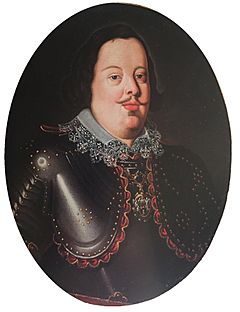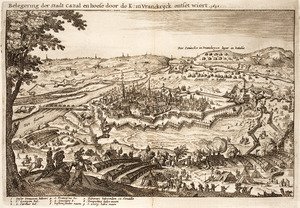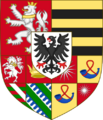War of the Mantuan Succession facts for kids
Quick facts for kids War of the Mantuan Succession |
|||||||
|---|---|---|---|---|---|---|---|
| Part of the Thirty Years' War | |||||||
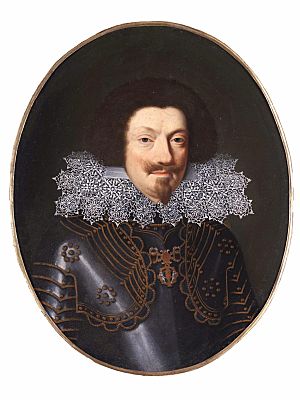 The successful claimant, Charles I Gonzaga, Duke of Mantua |
|||||||
|
|||||||
| Belligerents | |||||||
| Supporting the Duke of Nevers: |
Supporting the Duke of Guastalla: |
||||||
| Commanders and leaders | |||||||
| Strength | |||||||
| 1628: Up to 14,000 Mantuan and French troops 1630: 17,500 Venetian troops and auxiliaries 6,400+ Franco-Mantuan troops in garrisons 2,500 Mantuan troops French field army up to 20,000 |
1628: 29,000 Spanish 8,000 Savoyard 1630: 34,000 Spanish 30,000 Imperial Army 25,000 Savoyard troops 4,000 Tuscan 2,000 Parman |
||||||
The War of the Mantuan Succession (1628–1631) was a conflict linked to the larger Thirty Years' War. It began because Vincenzo II, the last male ruler of the House of Gonzaga, died in December 1627. He ruled the important areas of Mantua and Montferrat.
These lands were very important for controlling the Spanish Road. This was a land route that allowed Habsburg Spain to move soldiers and supplies from Italy to their army in Flanders. The war was like a fight between two powerful sides: France supported Charles, Duke of Nevers, who was French. Spain supported Ferrante II, Duke of Guastalla, a distant cousin.
The main battles happened around the strong fortress of Casale Monferrato. The Spanish army tried to capture it twice. The first siege was from March 1628 to April 1629. The second was from September 1629 to October 1630. France helped Nevers in April 1629. This made Emperor Ferdinand II send his troops from Northern Germany to help Spain. These Imperial troops captured Mantua in July 1630.
However, more French soldiers arrived, helping Nevers keep Casale. Emperor Ferdinand also pulled his troops out because Sweden joined the Thirty Years' War. Both sides agreed to a truce in October 1630. The Treaty of Cherasco in June 1631 confirmed Nevers as the Duke of Mantua and Montferrat. He gave up only a small amount of land.
More importantly, France kept control of Pinerolo and Casale. These were key fortresses that controlled mountain passes through the Alps. They also protected France's southern borders. The war made the Emperor and Spain use their resources in Italy instead of Germany. This allowed the Swedes to become strong in the Holy Roman Empire. This was one reason why the Thirty Years' War continued until 1648.
Contents
Why the War Started
Since 1308, the Duchy of Mantua had been ruled by the House of Gonzaga. They also gained the Duchy of Montferrat in 1574 through marriage. Both areas were part of the Holy Roman Empire. They were also very important for controlling Lombardy, which was ruled by Spanish Milan.
Controlling this region allowed the Habsburg rulers of Spain and Austria to threaten France's southern provinces. It also protected the important supply route called the Spanish Road. Spanish lands in Lombardy and the Kingdom of Naples provided many soldiers and supplies. These areas were the base of "Spanish power in Europe" during the 1600s.
Spain had recently gained more control over places like Finale and fortresses in Modena and Mirandola. This made their rivals, the Republic of Venice and Pope Urban VIII, worried.
In February 1627, Vincenzo II became Duke of Mantua and Montferrat. He was the last male in his family line. Knowing he was sick, he tried to decide who would rule next. It was complicated because Montferrat allowed women to inherit, but Mantua did not. Also, while these duchies acted like independent states, they were technically part of the Holy Roman Empire. This meant the Holy Roman Emperor had some say in who would rule.
The strongest person to take over was Charles Gonzaga, Duke of Nevers. He was a cousin of Vincenzo II and a French nobleman. Spain worried that if these duchies came under French influence, it would harm their interests. Córdoba, the Spanish governor of Lombardy, started talking about military action.
Other possible rulers included Charles Emmanuel I, Duke of Savoy, who mainly claimed Montferrat. Another was Ferrante II Gonzaga, Duke of Guastalla, a distant Gonzaga cousin. To make his claim stronger, Charles of Nevers arranged for his son Charles II Gonzaga to marry Vincenzo's niece, Maria Gonzaga. She was the heiress of Montferrat. The wedding happened on December 23, 1627, just three days before Vincenzo died. Nevers arrived in Mantua on January 17 and asked Emperor Ferdinand II to recognize him as the new ruler.
Goals of the Warring Sides
Historians say that "none of the major powers...was looking for a fight in Italy." The conflict happened due to several reasons. These included misunderstandings between Córdoba and Madrid, and Nevers' refusal to compromise. Even though Spain and Austria were both ruled by the Habsburg family, they didn't always want the same things.
Spain always wanted to be stronger in Northern Italy. Emperor Ferdinand wanted to avoid moving soldiers from Germany. He also wanted to show his power by deciding who would rule Mantua. He agreed to let Nevers be duke if Nevers gave up the new fortress of Casale Monferrato. This fortress was the capital of Montferrat. The Emperor's wife, Empress Eleonora, who was Vincenzo II's sister, suggested this idea.
This solution seemed good, especially since the French chief minister, Cardinal Richelieu, was busy with the Siege of La Rochelle. However, the plan was ruined by Córdoba and Charles Emmanuel. They had fought over Montferrat before (1613–1617). Just before Vincenzo died, they agreed to divide the duchy. Most of it would go to Savoy, and Spain would get Casale. Philip IV of Spain and his chief minister Olivares approved this deal.
On January 26, Ferdinand told Córdoba not to send troops into Mantua or Montferrat. On April 1, he took control of both areas until a final decision was made. But by then, it was too late to stop the fighting.
In the 1600s, even big countries like France found it hard to fight in many places at once. So, they tried to make new alliances against their enemies. The Habsburgs did the same. Emperor Ferdinand didn't have his own army. He relied on his German allies or expensive mercenaries. Spain had huge resources, but fighting in Italy meant they had to stop operations in Flanders. The Mantuan war forced the Habsburgs to defend themselves in Germany. This had a big effect on the Thirty Years War.
First Phase: 1628 to 1629
Olivares and Philip thought Casale would be captured quickly. But Córdoba took several months to gather 12,000 soldiers for Montferrat. Savoy added 8,000 troops. Another 11,000 soldiers were already in the Duchy of Milan. An extra 6,000 soldiers guarded Cremona and blocked mountain passes.
The siege of Casale only began in March. Casale was one of the largest and most modern forts in Europe. Capturing it would take a long time. This gave Nevers time to build an army. With local soldiers and French mercenaries, he gathered 14,000 men. This included 2,000 cavalry, a large number for a small duchy. Nevers also had support from Empress Eleonora, Venice, and the Pope. Even Ferdinand's military commander, Wallenstein, supported Nevers. Wallenstein wanted his army to focus on capturing Stralsund in Northern Germany. These reasons delayed any Imperial help until September 1629.
Savoyard forces, led by Charles Emmanuel, captured Trino in April. Then they took Nizza Monferrato in June. But the siege of Casale continued slowly. Taking money and soldiers from the war against the Dutch Republic weakened Spain. Philip later said attacking Casale was his biggest regret. But once they started, Spain couldn't back down. Spain now recognized Guastalla as Duke of Mantua, even though Olivares admitted Nevers was the rightful heir.
Nevers raised another 6,600 men by using his French lands as collateral. Most of these soldiers were attacked and destroyed by Charles Emmanuel while crossing the Alps. The surrender of La Rochelle in October 1628 allowed France to get involved directly. In March 1629, a French army led by Louis XIII of France broke through defenses at Pas de Suse. By the end of the month, they had ended the siege of Casale. They also took the important Savoyard fortress of Pinerolo.
In April, France, England, and Savoy signed the Treaty of Susa. This treaty had two parts. The first ended the Anglo-French War (1627–1629). The second made peace between France and Savoy. Charles Emmanuel allowed French troops to stay in Casale and Pinerolo. He also gave them free passage to send help to Mantua. Louis XIII and most of the French army then returned to Languedoc. They went to stop the latest Huguenot rebellions.
Second Phase: 1629 to 1630
Philip wanted to undo the Susa treaty. He replaced Córdoba with Spinola, a general from Genoa. Nevers unwisely led 2,500 troops to attack Spanish-held Cremona. His Venetian allies refused to help. This, along with the main French army leaving, left him open to attack. Richelieu placed 18,000 French troops near Savoy to stop Imperial help. But Emperor Ferdinand thought fighting the French in Italy was more important than helping Spain against the Dutch.
The June 1629 Treaty of Lübeck ended his war with Denmark-Norway. This allowed Ferdinand to send 30,000 troops from Germany. These troops were led by Ramboldo, Count of Collalto, a Mantuan exile. Spinola hoped to capture Casale quickly. He added 12,000 mercenaries and 6,000 soldiers from Naples to his 16,000 men. He also used treaties with Tuscany and Parma to get 4,000 and 2,000 men. But many of his soldiers were not well trained.
The siege of Casale and its 2,500 French defenders began again in June. In late October, Collalto defeated a Venetian force of 7,000. Then he moved to Mantua, which had a garrison of 4,000.
Neither siege went well. Mantua was protected by two lakes, making it hard to place cannons. Collalto pulled back after a failed attack in November. Collalto became sick, so Gallas and Aldringen took command. Casale continued to hold out. The Spanish could not pay or support so many men. Many soldiers left or died from disease.
Charles Emmanuel changed sides again. In December, he joined Spinola at Casale with 6,500 men. He left 12,500 to guard Piedmont and 6,000 in Savoy. Tuscany, Parma, and other Spanish allies sent more soldiers and money. A French army of 18,000 under Henri II de Montmorency took over Savoy. Then they invaded Piedmont in February 1630. On July 10, Montmorency defeated a combined Savoyard-Spanish force at Avigliana.
Both sides suffered badly from an outbreak of bubonic plague. It was supposedly brought from Germany by soldiers. This was the "worst mortality crisis" in Italy during that time. About 35% of Northern Italy's population died between 1629 and 1631. The war became very brutal. There were several massacres. In April 1630, at Ostiglia, local bandits attacked Imperial soldiers. After the bandits were defeated, Imperial troops attacked the local people. Around 600 people, including women and children, were killed.
When the siege of Mantua started again in May 1630, its defenders were down to under 2,000 due to disease. A quickly gathered Venetian relief force of 17,500 was defeated at Villabuona. The Mantuan soldiers, unpaid and rebellious, were down to only 700. They surrendered to Gallas and Aldringen on July 18. The city was looted, with stolen goods worth over 18 million ducats. The plague and the looting reduced Mantua's population by over 70% between 1628 and 1631. It took decades for the city to recover.
Despite this, Nevers' cause was still alive because Casale held out. On July 26, Charles Emmanuel died. His son Victor Amadeus took over. He was married to Christine of France, Louis XIII's younger sister. On August 6, Montmorency defeated the Savoyards at Carignano. But he had lost too many men to disease and desertion to help Casale. However, reinforcements under Charles de Schomberg reached the fortress in early October. Heavy rain flooded the siege works. The attackers were reduced by plague to under 4,000. Spinola, their commander, also died. On October 29, the Spanish finally left. Both sides agreed to a truce, arranged by the papal representative Mazarin.
Peace and What Happened Next
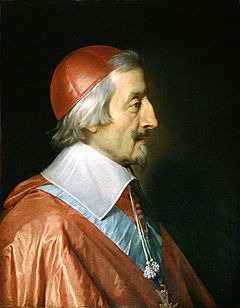
In June 1630, Richelieu sent his close aide Father Joseph and Nicolas Brûlart to peace talks. These talks were with Ferdinand in Regensburg. At the same time, Gustavus Adolphus landed in Pomerania with 18,000 troops. This marked the start of the Swedish intervention in the Thirty Years' War. Father Joseph also had secret orders to seek an alliance with Ferdinand's main Catholic supporter, Maximilian I, Elector of Bavaria.
However, Mantua's fall on July 18 seemed to hurt France's position in Italy. Maximilian was not interested in an alliance. Seeing a chance, Ferdinand offered to confirm Nevers as Duke of Mantua. In return, France would give Casale and Pinerolo to Spain. France would also stop supporting Ferdinand's enemies in the Empire, like the Swedes and the Dutch. This offer came when Louis XIII was very sick. His enemies tried to attack Richelieu's power. This made the government unable to act. Father Joseph couldn't get new orders. So, on October 13, he reluctantly signed the Treaty of Ratisbonne.
This agreement went against France's main foreign policy goal: to weaken the Habsburgs. It also threatened their alliance with the Pope. The Pope wanted to free Italy from "Spanish control." Louis, having recovered from his illness, refused to approve the treaty. Richelieu kept his power and continued to control French policy until he died in 1642. In January 1631, Louis gave Gustavus financial help in the Treaty of Bärwalde. This allowed the Swedes to become strong in the Empire, where they stayed until 1648. In May, the Treaty of Fontainebleau followed. This was an eight-year agreement between France and Maximilian of Bavaria.
Ferdinand had to move Imperial troops from Italy to face the Swedish threat. This forced him to sign the Treaty of Cherasco with France on June 19, 1631. This treaty confirmed Nevers as Duke of Mantua and Montferrat. Nevers made only small land concessions to Savoy. Both sides agreed to remove their armies. But Nevers and Victor Amadeus allowed French soldiers to stay in Casale and Pinerolo. This meant Spain gained nothing from the conflict, despite spending 10 million escudos and thousands of men.
The war was a big success for Richelieu's foreign policy. It made France stronger in Northern Italy. It disrupted the Spanish Road. It also permanently damaged relations between Spain and Austria. Even more important in the long run was the split it created between the Habsburgs and the Pope. This made it okay for France to use Protestant allies against other Catholics.
Images for kids
See also
 In Spanish: Guerra de Sucesión de Mantua para niños
In Spanish: Guerra de Sucesión de Mantua para niños


